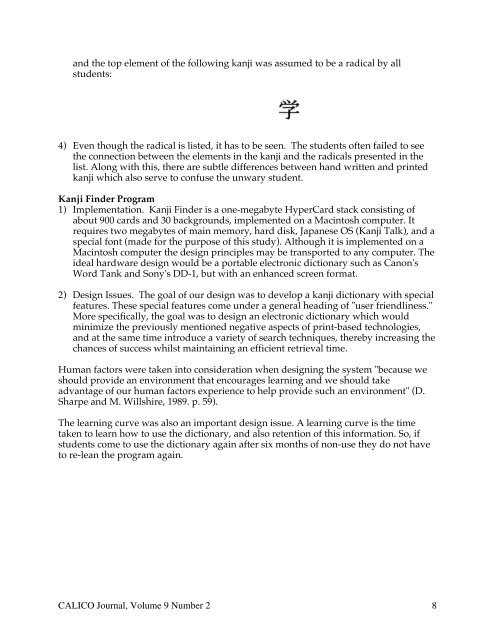Kanji Retrieval by Recursive Location of Elements Using HyperCard
Kanji Retrieval by Recursive Location of Elements Using HyperCard
Kanji Retrieval by Recursive Location of Elements Using HyperCard
You also want an ePaper? Increase the reach of your titles
YUMPU automatically turns print PDFs into web optimized ePapers that Google loves.
and the top element <strong>of</strong> the following kanji was assumed to be a radical <strong>by</strong> all<br />
students:<br />
4) Even though the radical is listed, it has to be seen. The students <strong>of</strong>ten failed to see<br />
the connection between the elements in the kanji and the radicals presented in the<br />
list. Along with this, there are subtle differences between hand written and printed<br />
kanji which also serve to confuse the unwary student.<br />
<strong>Kanji</strong> Finder Program<br />
1) Implementation. <strong>Kanji</strong> Finder is a one-mega<strong>by</strong>te <strong>HyperCard</strong> stack consisting <strong>of</strong><br />
about 900 cards and 30 backgrounds, implemented on a Macintosh computer. It<br />
requires two mega<strong>by</strong>tes <strong>of</strong> main memory, hard disk, Japanese OS (<strong>Kanji</strong> Talk), and a<br />
special font (made for the purpose <strong>of</strong> this study). Although it is implemented on a<br />
Macintosh computer the design principles may be transported to any computer. The<br />
ideal hardware design would be a portable electronic dictionary such as Canon's<br />
Word Tank and Sony's DD-1, but with an enhanced screen format.<br />
2) Design Issues. The goal <strong>of</strong> our design was to develop a kanji dictionary with special<br />
features. These special features come under a general heading <strong>of</strong> "user friendliness."<br />
More specifically, the goal was to design an electronic dictionary which would<br />
minimize the previously mentioned negative aspects <strong>of</strong> print-based technologies,<br />
and at the same time introduce a variety <strong>of</strong> search techniques, there<strong>by</strong> increasing the<br />
chances <strong>of</strong> success whilst maintaining an efficient retrieval time.<br />
Human factors were taken into consideration when designing the system "because we<br />
should provide an environment that encourages learning and we should take<br />
advantage <strong>of</strong> our human factors experience to help provide such an environment" (D.<br />
Sharpe and M. Willshire, 1989. p. 59).<br />
The learning curve was also an important design issue. A learning curve is the time<br />
taken to learn how to use the dictionary, and also retention <strong>of</strong> this information. So, if<br />
students come to use the dictionary again after six months <strong>of</strong> non-use they do not have<br />
to re-lean the program again.<br />
CALICO Journal, Volume 9 Number 2 8
















